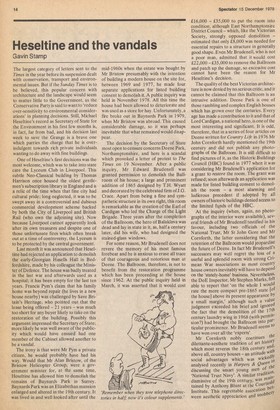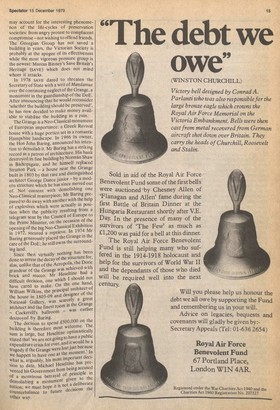Hese!tine and the vandals
Gavin Stamp
The largest category of letters sent to the Times in the year before its suspension dealt with conservation, transport and environmental issues. But if the Sunday Times is to be believed, this popular concern with architecture and the landscape would seem to matter little to the Government, as the Conservative Party is said to want to 'reduce over-sensitivity to environmental considerations' in planning decisions. Still, Michael Heseltine's record as Secretary of State for the Environment in his first few months is, in fact, far from bad, and his decision last week to save the Grange is a brave one which parries the charge that he is overindulgent towards rich private individuals wanting to do away with fine buildings.
One of Heseltine's first decisions was the most welcome, which was to take into state care the Lyceum Club in Liverpool. This subtle Neo-Classical building by Thomas Harrison once housed the oldest gentlemen's subscription library in England and is a relic of the time when that fine city had cultural pride; long neglected, it was to be swept away in a controversial and dubious commercial development scheme backed by both the City of Liverpool and British Rail (who own the adjoining site). Now because Liverpool cannot apparently look after its own treasures and despite one of those unfortunate fires which often break out at a time of controversy, the Lyceum is to be protected by the central government.
Last month it was announced that Heseltine had rejected an application to demolish the early-Georgian Hasells Hall in Bedfordshire, made by his colleague the Minister of Defence. The house was badly treated in the last war and afterwards used as a hospital; it has been empty for the last ten years. Francis Pym's claim that his family home was beyond repair (he lives in a new house nearby) was challenged by Save Britain's Heritage, who pointed out that the lease being offered — 21 years — was much too short for any buyer likely to take on the restoration of the building. Possibly this argument impressed the Secretary of State; more likely he was well aware of the publicity which would have ensued had one member of the Cabinet allowed another to be a vandal.
The irony is that were Mr Pym a private citizen, he would probably have had his way. Would that Mr Alan Bristow, of the Bristow Helicopter Group, were a government minister for, at the same time, Heseltine has allowed him to demolish the remains of Baynards Park in Surrey. Baynards Park was an Elizabethan mansion enlarged and altered in the 19th century. It was lived in and well looked after until the mid-1960s when the estate was bought by Mr Bristow presumably with the intention of building a modern house on the site for, between 1969 and 1977, he made four separate applications for listed building consent to demolish it. A public inquiry was held in November 1978. All this time the house had been allowed to deteriorate and was used as a store for hay. Unfortunately, a fire broke out in Baynards Park in 1979, when Mr Bristow was abroad. This caused considerable damage, so it was perhaps inevitable that what remained would disappear.
The decision by the Secretary of State most open to censure concerns Deene Park, Northamptonshire, and here is a scandal which provoked a letter of protest to The Times on 19 November. After a public inquiry, Mr Edward Brudenell was granted permission to demolish the Ballroom of his house; a large and prominent addition of 1865 designed by T.H. Wyatt and decorated by the celebrated firm ofJ.G. Crace. Apart from being a fine and sympathetic structure in its own right, this room is remarkable as the creation of the Earl of Cardigan who led the Charge of the Light Brigade. Three years after the completion of the Ballroom, the hero of Balaklava was dead and lay in state in it, as, half a century later, did his wife, who had designed the stained-glass windows.
For some reason, Mr Brudenell does not revere the memory of his most famous forebear and he is anxious to erase all trace of that courageous and notorious man at Deene. The Ballroom, therefore, is not to benefit from the restoration programme which has been proceeding at the house since 1962. At the public inquiry held in March, it was asserted that it would cost 116,000 — £35,000 to put the room into condition, although East Northamptonsire District Council — which, like the Victorian Society, strongly opposed demolition — estimated that only £8,000 was needed for • essential repairs to a structure in generally good shape. Even Mr Brudenell, who is not a poor man, admitted that it would cost £22,000 —£35,000 to remove the Ballroom and patch up the damage, so excessive cost cannot have been the reason for Mr Heseltine's decision.
The quality of the best Victorian architecture is now denied by no.serio us critic, and it cannot be claimed that this Ballroom is an intrusive addition. Deene Park is one of those rambling and complex English houses which has grown over the centuries. Every age has made a contribution to it and that of Lord Cardigan, a national hero, is one of the most interesting and significant. It is odd, therefore, that in a series of four articles on Deene written for Country Lift in 1976 Mr John Cornforth hardly mentioned the 19th century and' did not publish any photographs of the Ballroom. It is still difficult to find pictures of it, as the Historic Buildings Council (HBC) found in 1977 when it was considering Mr Brudenell's application for a grant to restore the room. The grant was refused; soon afterwards an application was made for listed building consent to demolish the room — a most alarming and ludicrous precedent if adopted by all owners of historic buildings denied access to the limited funds of the HBC.
At the inquiry (when, again, no photographs of the interior were available), several friends of Mr Brudenell testified in his favour, including two officials of the National Trust, Mr St John Gore and Mr Cornforth, the latter considering that the retention of the Ballroom would jeopardise the future of Deene. In fact Mr Brudenell's successors may well regret the loss of a useful and splendid room with strong Crimean War associations as most countrY house owners inevitably wilihave to depend on the 'stately-home' business. Nevertheless, the DoE Inspector, Mr Stephen Marks, felt able to report that 'on the whole I would rate the more compact pre-1865 state [of the house] above its present appearance bY a small margin,' although such a value judgment exceeded his brief and ignored the fact that the demolition of the 17th century laundry wing in 1968 (with permission?) had brought the Ballroom into particular prominence. Mr Brudenell seems t° have won over all the 'experts'. Mr Cornforth nobly continues the dilettante-aesthete tradition of art historY which most reveres the 18th century and' above all, country houses — an attitude social advantages which was wtekediflY analysed recently in Harpers iSt Que,e'ithe discussing the smart young men 01 'National Trust Navy'. A similar traditionn_ dismissive of the 19th century, was maul' d tamed by Anthony Blunt at the Court! _t. Institute. This regrettable assocation ween aesthetic appreciation and snobb may account for the interesting phenomenon of the life-cycles of preservation societies: from angry protest to complacent compromise —not wishing to offend friends. The Georgian Group has not saved a building in years, the Victorian Society is probably at the apogee of its effectiveness while the most vigorous pressure group is the newest: Marcus Binney's Save Britain's Heritage (SAvE) which does not mind whom it attacks.
In 1978 SAVE dared to threaten the Secretary of State with a writ of Mandamus over the continuing neglect of the Grange, a monument in the guardianship of the DoE. After announcing that he would reconsider 'whether the building should be preserved', he has now decided to make money available to stabilise the building as a ruin.
The Grange is a Neo-Classical monument of European importance: a Greek Revival house with a huge portico set in a romantic Hampshire landscape. In 1966 its owner, the Hon John Baring, announced his inten tion to demolish it. Mr Baring has a striking record as a patron of architecture. His bank destroyed its fine building by Norman Shaw in Bishopsgate, and he himself reiilaced Stratton Park — a house near the Grange built in 1803 by that rare and distinguished architect George Dance junior — by a modern structure which he has since moved out of. Not content with demolishing one Neo-Classical masterpiece, Mr Baring prepared to do away with another with the help of explosives which were actually in position when the publicity resulting from a telegram sent by the Council of Europe to the Prime Minister, on the occasion of the opening of the big Neo-Classical Exhibition in 1972, secured a reprieve. In 1974 Mr Baring generously placed the Grange in the care of the DoE; he still owns the surrounding land. Since then virtually nothing has been done to arrest the decay of the structure for, alas, unlike that of the Acropolis, the Doric grandeur of the Grange was achieved with brick and stucco. Mr Heseltine had a difficult decision, one which I should not have cared to make. On the one hand, William Wilkins, the principal architect-of the house in 1805-09 and designer of the National Gallery, was scarcely a great architect and the finest room in the Grange Cockerell's ballroom — was earlier destroyed by Baring. The decision to spend £500,000 on the building is therefore most welcome. The sum is large, but Heseltine optimistically stated that 'we are not going to have a public expenditure crisis for ever, and it would be a tragedy if the Grange were lost just because we happen to have one at the moment. In What is, arguably, his most important decision to date, Michael Heseltine has prevented his Government from being accused of a monstrous betrayal of principle in demolishing a monument given to the nation; we must hope it is not a deliberate Counterbalance to future decisions the Other way.



































 Previous page
Previous page